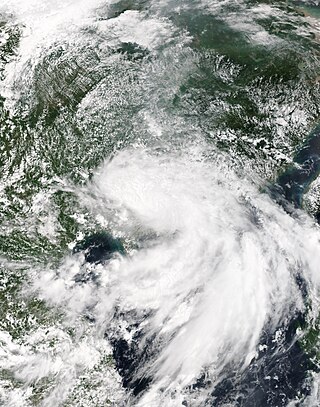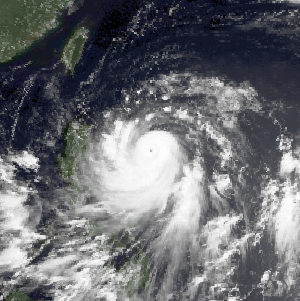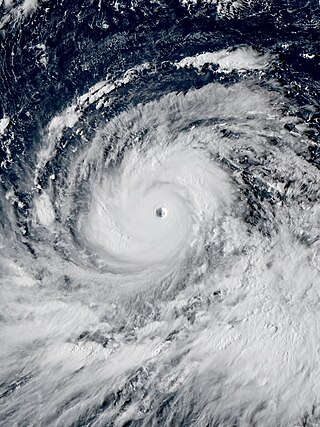
Pedder Street is a major thoroughfare in the core of Hong Kong's Central District. It runs south–north from Queen's Road Central,continues through Des Voeux Road Central,and ends at its intersection with Connaught Road Central.

Typhoon Chanchu,known in the Philippines as Typhoon Caloy,was the most intense typhoon in the South China Sea in the month of May according to the Hong Kong Observatory (HKO). The first named storm of the 2006 Pacific typhoon season,Chanchu formed on May 8 in the vicinity of the Federated States of Micronesia and progressed westward. It gradually intensified into a tropical storm and later severe tropical storm before moving through the Philippines. On May 13,Chanchu entered the South China Sea and became a typhoon,according to the Japan Meteorological Agency (JMA). Warm waters and favorable outflow allowed the storm to quickly intensify to peak maximum sustained winds of 175 km/h (109 mph) on May 15. Around that time,the typhoon turned sharply to the north toward southeastern China. Chanchu weakened as it curved to the northeast,making landfall near Shantou,Guangdong on May 17 as a severe tropical storm. The government of China considered Chanchu the earliest typhoon to make landfall in the province. On the next day,the storm emerged into the East China Sea,becoming extratropical on May 19 before dissipating west of Kyushu.

Typhoon Wanda was one of the most intense tropical cyclones on record in Hong Kong. It was the 59th disturbance in the record-breaking 1962 Pacific typhoon season,forming in August east of the Philippines. Typhoon Wanda reached peak winds of 175 km/h (110 mph) in the South China Sea,and it made landfall on Hong Kong on September 1,producing gusts of 261 km/h (161 mph) which,in combination with a high storm surge,damaged thousands of huts and left 72,000 people homeless. Wanda left a total of 434 deaths,and it is estimated that an identical typhoon striking today would cause HK$2.6 billion in losses.

The Hongkong Hotel was Hong Kong's first luxury hotel modelled after sumptuous London hotels. It opened on Queen's Road and Pedder Street in 1868,later expanding into the Victoria Harbour waterfront of Victoria City in 1893.

The 1937 Great Hong Kong Typhoon was one of the deadliest typhoons in Hong Kong history,with a death toll estimated between 11,000 and 13,000. Part of the 1937 Pacific typhoon season,the tropical cyclone originated on 24 August to the south of Guam,which proceeded generally to the west-northwest. On 1 September the storm entered the South China Sea,and early the next day,the typhoon passed just south of Hong Kong before making landfall in southern China. It weakened after moving ashore,dissipating on 3 September.

The 2017 Pacific typhoon season was a below-average season in terms of accumulated cyclone energy and the number of typhoons and super typhoons,and the first since the 1977 season to not produce a Category 5-equivalent typhoon on the Saffir–Simpson scale. The season produced a total of 27 named storms,11 typhoons,and only two super typhoons,making it an average season in terms of storm numbers. It was an event in the annual cycle of tropical cyclone formation,in which tropical cyclones form in the western Pacific Ocean. The season runs throughout 2017,though most tropical cyclones typically develop between May and October. The season's first named storm,Muifa,developed on April 25,while the season's last named storm,Tembin,dissipated on December 26. This season also featured the latest occurrence of the first typhoon of the year since 1998,with Noru reaching this intensity on July 23.

Typhoon Clara,known in the Philippines as Typhoon Rubing,left flooding in the northern Philippines and southern China during September 1981. An area of disturbed weather was first detected on September 11 near Ponape. After moving westward,the system gradually became better organized and thunderstorm activity increased. On September 16,the system attained tropical storm status. Two days later,Clara attained typhoon intensity and subsequently began to deepen at a faster rate. On September 19,Clara reached maximum intensity,before making landfall along the northern tip of Luzon. Clara steadily weakened after interacting with land,but by late on September 20,Clara leveled off in intensity over the South China Sea. The next day,Clara moved ashore to the east-northeast of Hong Kong while still at typhoon intensity before rapidly dissipating over land.

Typhoon Vicente,known in the Philippines as Tropical Depression Ferdie,was the strongest tropical cyclone to strike the Chinese province of Guangdong since Hagupit in 2008,and was regarded as the strongest storm to affect Hong Kong and Macau in more than ten years. The eighth named storm and third typhoon of the 2012 Pacific typhoon season,Vicente began as a tropical depression on July 18,2012 northeast of the Philippines. Vicente soon steadily moved into the South China Sea,and began to intensify above warm sea waters,and began explosive intensification early on July 23,and started to charge toward the Guangdong region prompting the Hong Kong Observatory (HKO) to issue the Hurricane Signal,No. 10,the first since York in 1999. The Macao Meteorological and Geophysical Bureau also hoisted Signal No. 9 for the first time since York and after the transfer of sovereignty over Macau. Late on the same day,Vicente made landfall over Taishan in Guangdong,China.

The 1906 Hong Kong typhoon was a tropical cyclone that hit Hong Kong on 18 September 1906. The natural disaster caused property damage exceeding a million pounds sterling,affected international trade,and took the lives of around 15,000 people.
The 1908 Hong Kong Typhoon was a tropical cyclone which made landfall near Hong Kong on the night of 27 July 1908. The storm resulted in significant property damage and loss of life. The most notable occurrence of the event was the loss of the SS Ying King (英京號),a steamship,which sank while trying to seek shelter from the storm;421 people on board drowned. About one thousand people were reported to have drowned,more than 20 houses collapsed,and many Hong Kong wharf facilities were damaged. As a result of the catastrophe,additional safety measures were undertaken,including the construction of a second typhoon shelter in Hong Kong harbour.

Typhoon Ellen,known in the Philippines as Typhoon Herming,was considered the worst typhoon to hit China since 1979. Typhoon Ellen was first noted as a tropical disturbance east of the International Date Line on August 26,1983,and became a tropical storm soon after crossing the dateline on the morning of August 29. Initially,strong wind shear inhibited development over the next five days,and the cyclone began to track south of west. On September 2,conditions aloft finally improved and the cyclone strengthened into a typhoon on September 4 as it tracked west-northwest. Approaching Luzon late on September 5,Ellen intensified rapidly into a strong typhoon with winds of 200 km/h (125 mph) before interaction with Luzon began to weaken the cyclone. Its final landfall was at Portuguese Macau on the morning of September 9 as a minimal typhoon. The next day,Ellen ceased to exist.

Typhoon Ruby,known in the Philippines as Typhoon Yoning,was a strong tropical cyclone that struck Hong Kong,Macau,and southern China in early September 1964. The precursor disturbance to Ruby was first identified on August 29 over the Philippine Sea,and this system organised into a tropical cyclone by September 1. Ruby intensified as it moved west,becoming a typhoon the next day and subsequently passing over the Babuyan Islands of the Philippines. After reaching the South China Sea,Ruby turned northwest and intensified further,attaining peak ten-minute sustained winds of 195 km/h (121 mph) before making landfall at the peak intensity near Hong Kong on September 5. The typhoon weakened after moving inland and dissipated on September 6 over southeastern China.

Typhoon Mary,also nicknamed "Bloody Mary" by the Joint Typhoon Warning Center (JTWC),was an extremely damaging storm that was part of the 1960 Pacific typhoon season. It began as a circulation in a trough in the South China Sea. A tropical depression formed on June 2,as it was traveling clockwise. It became a tropical storm on the next day,and received the name Mary. It slowly moved across the sea,strengthening to a typhoon. Mary made landfall in Hong Kong on June 8,and moved through Guangdong and Fujian. It reemerged back to the Pacific Ocean,and restrengthened into a typhoon temporarily. It then traveled east,weakening and becoming extratropical on June 12.

Typhoon Dot was a strong tropical cyclone that made landfalls on Luzon and near Hong Kong in October 1964. It was the fifth typhoon to impact Hong Kong during the active 1964 Pacific typhoon season,and prompted the issuance of the No. 10 typhoon signal from the Royal Observatory in Hong Kong—the highest warning possible. The storm's precursor disturbance formed west of Pohnpei on October 3 and tracked towards the west,becoming a tropical storm by October 6. Gradually strengthening,Dot moved towards the west-northwest,northwest,and then curved west,leading to a landfall at typhoon intensity on Luzon on October 9. A freighter with 32 crewmembers went missing west of the island after passing through the typhoon and was never recovered.

In 1900,23 tropical cyclones were observed in the western Pacific Ocean,north of the equator and west of the International Date Line. In that region of the world,cyclones that attain maximum sustained winds of at least 118 km/h (73 mph) are known as typhoons. Of the 23 storms,13 were tracked by the Hong Kong Observatory. Activity occurred from January to December,although the majority of the storms formed from June to November.

Typhoon Hato,known in the Philippines as Severe Tropical Storm Isang,was a strong tropical cyclone that struck South China in August 2017. The thirteenth named storm and the fourth typhoon of the Pacific typhoon season,Hato formed as a tropical depression over the east of Luzon on 19 August. The system further developed and became a tropical storm the next day. On 21 August,Hato emerged over the northern portion of the South China Sea and reached typhoon intensity. Rapid intensification ensued on 23 August,and Hato became a Category 3-equivalent typhoon before making landfall over Jinwan,Zhuhai. The storm further weakened over land and dissipated on 24 August.

Severe Tropical Storm Pakhar,known in the Philippines as Tropical Storm Jolina,was a strong tropical storm that impacted the Philippines and South China during late August 2017. The storm followed Typhoon Hato which affected the same areas just a few days prior. Pakhar,the fourteenth named storm of the 2017 Pacific typhoon season,developed from a tropical depression to the east of Luzon during August 24 and intensified into a tropical storm later that day. Pakhar then made landfall in Aurora on August 25,before gradually intensifying and peaking as a severe tropical storm by August 27,making landfall over Taishan,Jiangmen in Guangdong Province.

Typhoon Warren,known in the Philippines as Typhoon Huaning,struck the Philippines and China during July 1988. An area of disturbed weather developed within the vicinity of the Caroline Islands during the second week of July. A tropical depression developed southeast of Guam on July 12,and on the next day,intensified into a tropical storm. Tracking generally west-northwest,Warren deepened into a typhoon on July 14. The storm subsequently entered a period of rapid intensification,commencing with Warren reaching its highest intensity on July 16. The following evening,the typhoon brushed Luzon,resulting in a weakening trend,although Warren was still a typhoon when it made landfall near Shantou. Warren rapidly dissipated inland.

Typhoon Mangkhut,known in the Philippines as Super Typhoon Ompong,was a powerful and catastrophic tropical cyclone that caused extensive damage in Guam,the Philippines,and South China in September 2018. It was the strongest typhoon to strike Luzon since Megi in 2010,and the strongest to make landfall anywhere in the Philippines since Meranti in 2016. Mangkhut was also the strongest typhoon to affect Hong Kong since Ellen in 1983.

The following is a list of Pacific typhoon seasons from 1902 to 1919. Data from these years was extremely unreliable,so there were many more typhoons that did not hit land and were not detected by ships.




















